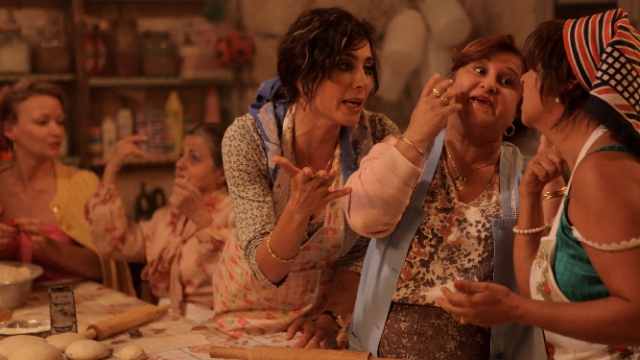
The logo for the television show Qanurli (What Now?)—which follows Inuk Qablunaaq (Thomas Anguti Johnston) as he lives off the land and hosts a TV show from a tent on the arctic tundra—features a high-top sneaker tied to a mukluk boot, hanging from a satellite. It’s a playful image, but one that also highlights the hybridity of modern and traditional Inuit life in northern Canada. This duality is the backbone of the series, the only comedy show of its kind aired entirely in Inuktitut (with English subtitles)[i] .
Billed as “Wayne’s World meets Saturday Night Live, Inuk-style,”[ii] Qanurli is the brainchild of producer Stacey Aglok MacDonald, a young Inuk woman in Iqaluit who has worked for a number of years in the North’s burgeoning film industry. In 2010, along with Anguti Johnston, Vinnie Karetak and musician Joshua Qaumariaq, they came up with an idea to look at life in the North and highlight language and Inuit culture. Documentaries about the Inuit had attempted to do this before (tracing back to 1922 and the ethnographic Nanook of the North), but it had never been done using humour.
Currently in its fifth season, Qanurli’s ongoing storyline focuses on the challenges goofball Inuk faces as he broadcasts from his tent with his best friend Nipangi. Early on, Inuk comes up with a plan to sell ad space to fund satellite costs, resulting in the fake commercials interspersed throughout the series. Along with sketches and spoof newscasts, these mock product placements make up the show-within-a-show. Although the situations depicted are specific to the Arctic (including commercials for faux hunter’s spray tan or Tuktu [caribou] Milk), the series’ appeal lies in the characters and their goofball antics. Good comedy has the ability to extend beyond borders, and viewers from the South can also enjoy Qanurli. While any production is hard to get off the ground, this is all the more true in a region where, until recently, the film industry was almost non-existent. A sense of humour is an asset under these circumstances, and luckily, Aglok MacDonald is someone who laughs readily and often. She can’t help but chuckle when talking about how much the crew has evolved since the early days. As a small team creating something never before attempted, they ended up doing everything themselves, working together as producers, prop and set designers, writers, editors, sound crew and camera operators.
“It led to a lot of creative thinking,” says Aglok MacDonald over the phone. “We used a lot of our internet bandwidth researching on YouTube tutorials.” She recalls an incident where most of an episode’s footage was overexposed, but instead of re-shooting the team decided to produce their first black-and-white episode. It’s this willingness to experiment that gives Qanurli its playfulness and youthful appeal.
Though the show’s original target audience was youth, its charm has garnered a following by folks of all ages. Young fans recognize the actors on the streets of Iqaluit, and elders have stopped by to see the studio. Focusing on the community and Inuit stories has always been important to Aglok MacDonald. She hails from a small hamlet, Kugluktuk, located in the westernmost region of Nunavut. As a child, she loved watching television and movies but wanted to become a lawyer or a writer—she eventually settled on becoming a teacher. Then, after moving to Iqaluit almost nine years ago, she participated in an educational documentary called Staking the Claim: Dreams, Democracy & Canadian Inuit (2010), which was incorporated into the territory’s high school curriculum.
In addition to appearing in front of the camera, Aglok MacDonald helped out as a production assistant; she has worked in film and television ever since, including producing the highly acclaimed short film Throat Song (2011), actor Miranda de Pencier’s directorial debut, about a young Inuk woman from a community affected by abuse, suicide and alcoholism.
Aglok MacDonald also recently wrapped up filming her first feature-length film, teaming up with de Pencier again to work on The Grizzlies, a project she’s been involved with for about seven years. Based on a true story, the movie focuses on a high school lacrosse program in Aglok MacDonald’s home community. The hamlet used to have the highest teen suicide rate in Canada, but the sports team-turned-athletics program changed the school and community landscape dramatically, greatly lifting student morale and boosting school attendance.
Aside from producing Qanurli, Aglok MacDonald is currently busy raising her daughter and is part of the team that owns and operates Qanukiaq Studios, a 100 per cent Inuit-owned company in Iqaluit that “specializes in creating, sharing and supporting stories from [the] Inuit perspective.”[iii] And from Qanurli to her other projects, Aglok MacDonald’s work is strongly connected to this mandate. “We’ve always had a talent of people up here—very creative, and just so many stories to be told. There’s no shortage of stories.”





